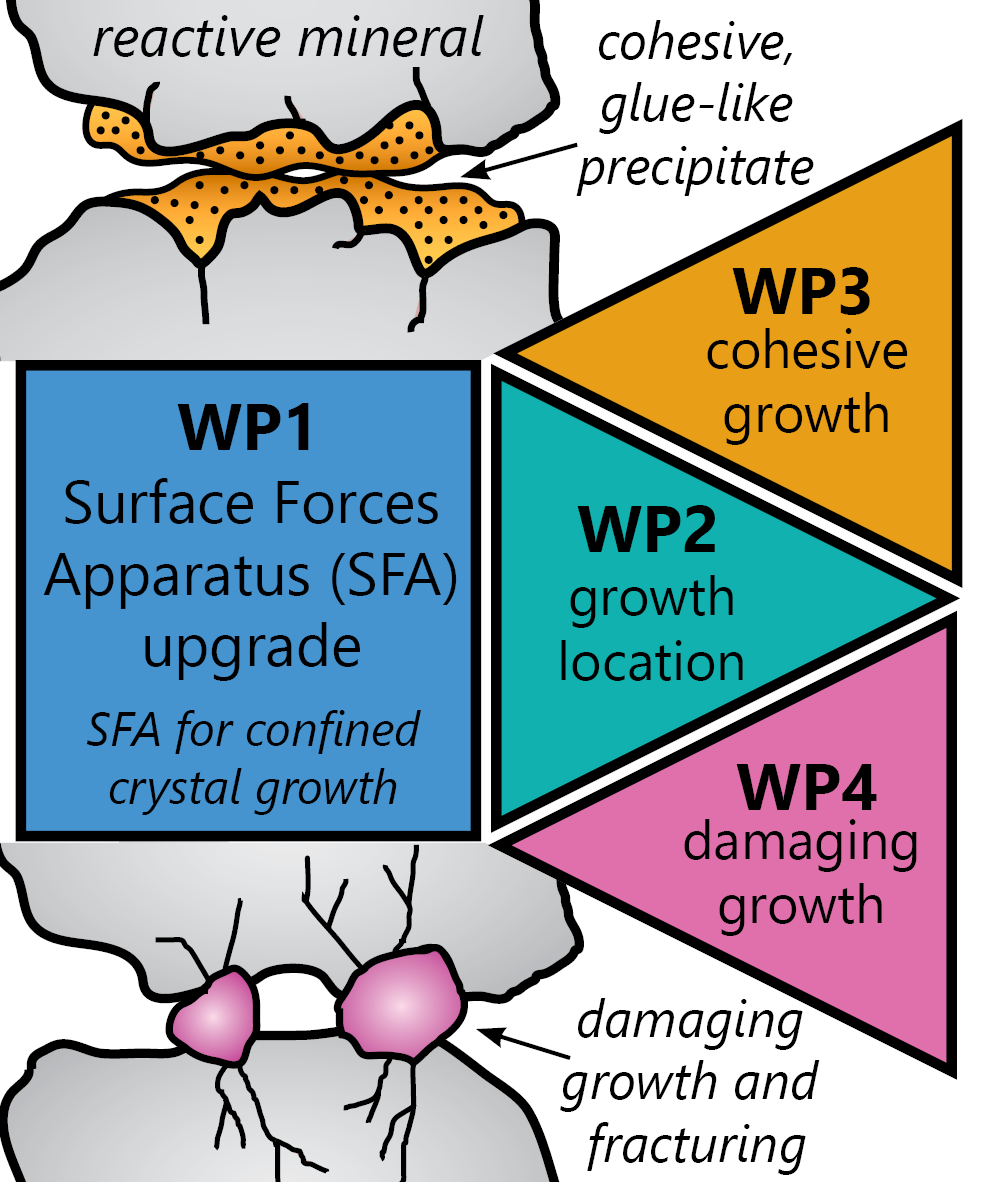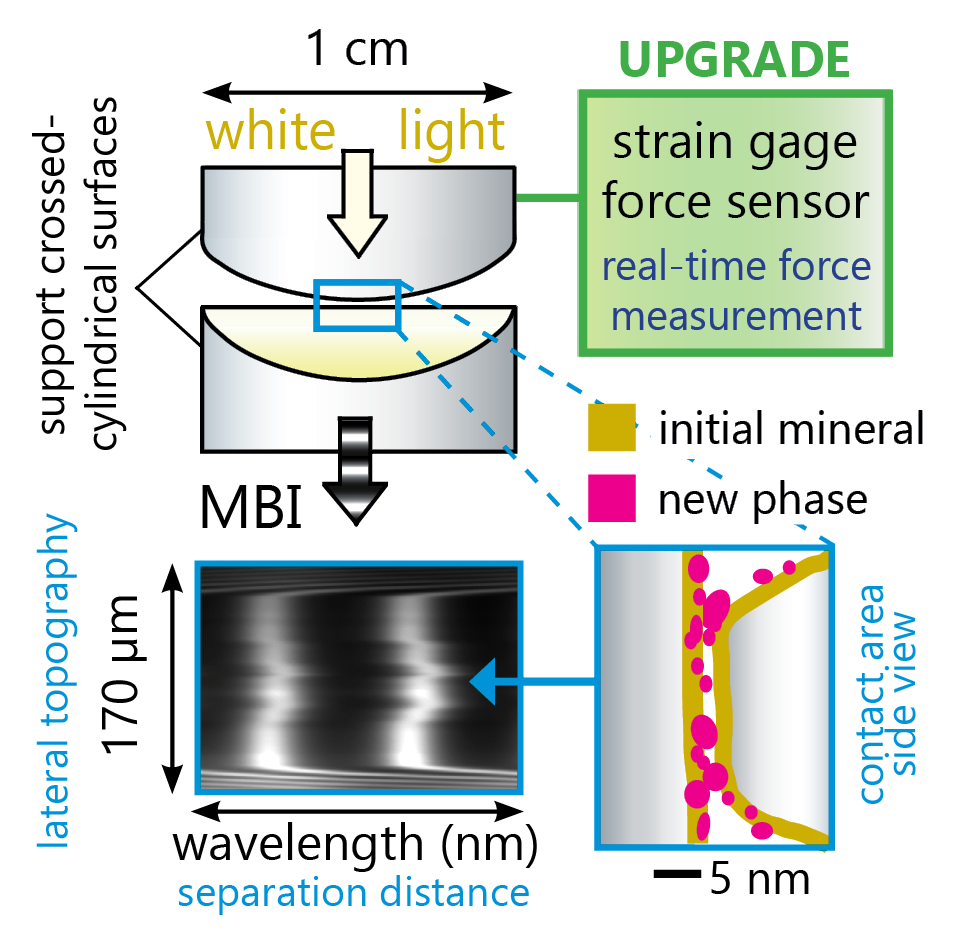About the project
Wherever water and other reactive fluids occur in porous media, minerals dissolve and new and more thermodynamically stable phases may precipitate in pores. Confined mineral crystallization is widespread and affects both natural and anthropogenic environments [1]. Depending on the setting, it may be perceived as undesirable or advantageous [2].
In both cases, the control of mineral growth in pores often becomes a pressing engineering challenge. Understanding and controlling mineral growth inside pores will benefit modern and future society and help addressing some of the current environmental challenges, as outlined below. Growing minerals frequently exert high crystallization pressures [3] and damage their surroundings. For example, crystallization of new minerals within the pores of stone and fabricated cementitious materials causes progressive disintegration and severe damage of cultural heritage and modern infrastructure [4].
Mineral replacement reactions within geological formations often lead to fracturing and thus to the loss of cohesion and mechanical strength of massive rock bodies. Injection of CO2 into porous reservoirs triggers changes in the existing mineral assemblages with unknown consequences for the reservoirs’ permeability and integrity [5], especially in locations where fast mineralization of pre-dissolved CO2 within two years is possible [6]. On the other hand, the growth of new minerals can also strengthen the host porous matrix. Mineral replacement and precipitation in Portland cement during its setting yields robust cohesion, making Portland cement one of the most abundantly used man-made, synthetic materials [7]. Microbially induced precipitation of calcium carbonate is used to stabilize granular materials, strengthen concrete, and heal cracks in materials undergoing weathering [8]. All these examples highlight the fact that real-life crystallization rarely occurs in bulk solution. Instead, it takes place in pore microenvironments. The complexity of mineral growth in confined volumes makes the crystallization outcome highly system specific. Thus, despite the tremendous importance of mineral crystallization under confinement, there is still no systematic understanding of these processes and their impacts on the immediate and more distant surroundings. Also, it is not clear why confinement effects can sometimes overcome the thermodynamic driving force for crystallization and suppress mineral growth [9]. The answer to this outstanding open scientific question is key for controlling mineral growth at the pore scale.
Primary Objective:
The primary objective of REACT is to understand and control the damaging and cohesive effects of mineral growth under spatial confinement.
Secondary objectives:
1. Establish a novel experimental framework for systematic measurements of the surface forces acting during mineral nucleation and growth in pores using the surface forces apparatus technique.
2. Explain which parameters govern the location of the growth of new phases under confinement.
3. Link the evolution of surface forces during reactive growth with the cohesive or damaging impacts on the host matrix.
4. Calculate average crystallization pressures during the growth of various minerals under confinement formed by surfaces in the surface forces apparatus.
5. Define key parameters needed to control damaging or cohesive mineral growth in small spaces.
Methodology
Experimental work in REACT will be based on surface forces apparatus (SFA), which is a uniquely capable technique for studying high-resolution distance-resolved forces between reacting macroscopic surfaces in-situ, as demonstrated in one of our previous works [10]. SFA enables an integrated investigation of confined reactivity because it can not only measure surface forces between two reactive macroscopic surfaces but also provide simultaneous, nanoscale interferometric information about the changing distance between confining walls (and thus the evolving contact area and change in the topographies of reactive surfaces). These features are not simultaneously accessible with any other experimental method. In addition, in REACT, we will use SFA with a strain gage force sensor [11], which allows facile in-situ real-time force measurement. The addition of force sensor is pivotal to measuring forces acting during confined mineral growth without an imposed change in surface separation, with surfaces placed in contact at a given externally applied load. Thus, we will be able to systematically investigate surface forces and average disjoining pressure during growth as a function of initial pore dimensions, without disrupting the pore geometry.
SFA enables an integrated investigation of confined reactivity because it can not only measure surface forces between two reactive macroscopic surfaces but also provide simultaneous, nanoscale interferometric information about the changing distance between confining walls (and thus the evolving contact area and change in the topographies of reactive surfaces). These features are not simultaneously accessible with any other experimental method. In addition, in REACT, we will use SFA with a strain gage force sensor [11], which allows facile in-situ real-time force measurement. The addition of force sensor is pivotal to measuring forces acting during confined mineral growth without an imposed change in surface separation, with surfaces placed in contact at a given externally applied load. Thus, we will be able to systematically investigate surface forces and average disjoining pressure during growth as a function of initial pore dimensions, without disrupting the pore geometry.
Funding
The Research Council of Norway, NFR Researcher Project for Young Talents (2024 – 2027). Project number: 344828
Background
1. Meldrum, F.C. and C. O'Shaughnessy, Crystallization in confinement. Advanced Materials, 2020. 32(31): p. 2001068.
2. Allard, C., Self-healing Roman concrete. Nature Reviews Materials, 2023. 8(2): p. 80-80.
3. Scherer, G.W., Crystallization in pores. Cement and Concrete research, 1999. 29(8): p. 1347-1358.
4. Flatt, R.J., et al., Chemo-mechanics of salt damage in stone. Nature communications, 2014. 5(1): p. 4823.
5. Matter, J.M. and P.B. Kelemen, Permanent storage of carbon dioxide in geological reservoirs by mineral carbonation. Nature Geoscience, 2009. 2(12): p. 837-841.
6. Snæbjörnsdóttir, S.Ó., et al., Carbon dioxide storage through mineral carbonation. Nature Reviews Earth & Environment, 2020. 1(2): p. 90-102.
7. Goyal, A., et al., The physics of cement cohesion. Science Advances, 2021. 7(32): p. eabg5882.
8. Peplow, M., Bioconcrete presages new wave in environmentally friendly construction. Nature Biotechnology, 2020. 38(7): p. 776-779.
9. Li, L., et al., Limits to crystallization pressure. Langmuir, 2022. 38(37): p. 11265-11273.
10. Dziadkowiec, J., et al., Nucleation in confinement generates long-range repulsion between rough calcite surfaces. Scientific reports, 2019. 9(1): p. 8948.
11. Wieser, V., et al., Novel in situ sensing surface forces apparatus for measuring gold versus gold, hydrophobic, and biophysical interactions. Journal of Vacuum Science & Technology A, 2021. 39(2).
